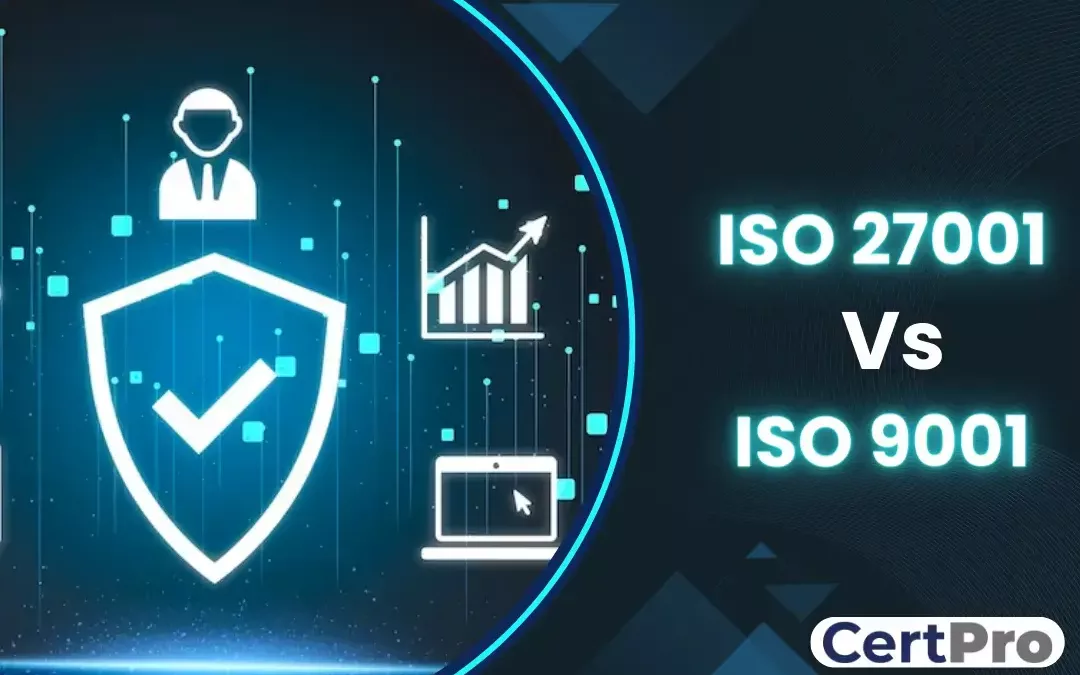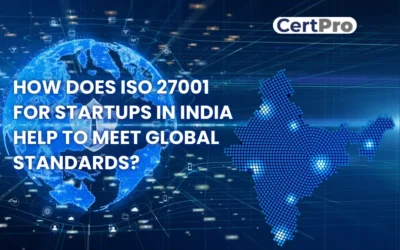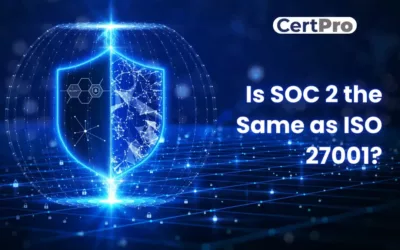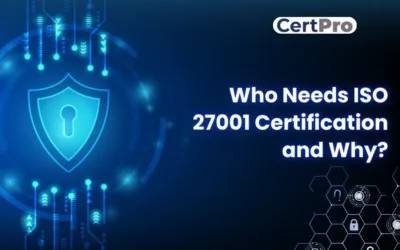Organizations are implementing different ISO standards to improve their functionality and scalability. Therefore, ISO 9001 is enforced to ensure the quality management systems of an organization. It helps to improve their products and services in the competitive market. On the other hand, ISO 27001 provides a compact information security framework for your organization. It helps protect sensitive information and prevent the risk of data breaches. Thus, you can compare ISO 9001 vs ISO 27001 and the common factors in these two regulations. We are comparing the rules as ISO 27001 ensures customers the security and integrity of their sensitive information. Hence, ISO 9001 signifies that the organization is improving its customer-facing systems by focusing on quality.
Now, the question arises of how is ISO 9001 different from ISO 27001. If your organization has already been certified with ISO 9001, there is no need to opt for ISO 27001. To justify your queries, you need to read the article carefully. In this blog, we discuss and analyze the differences between the two ISO regulations and find out the similarities and integration process. It will help you get ideas about the two ISO regulations and fulfill your queries.
ISO 27001 vs. ISO 9001
The ISO 27001 certification is a globally recognized standard in information security management systems. Certification bodies issue approval that signifies an organization’s commitment to aligning with the best information security management practices. ISO published the standard in 2005 and updated it in 2022. In addition, ISO 27001 offers the security of sensitive customer data. It shows your organization’s commitment to information security and safety in the customer handling process. Further, ISO 27001 certification avoids the risk of financial and reputational damage to your firm.
Conversely, ISO 9001 is an international standard for quality management systems. It focuses on customer satisfaction by improving your firm’s internal processes. The standard mainly concentrates on risk management, customer satisfaction, and continual process improvement. Again, it improves the firm’s reputation, enhances customer satisfaction, and helps with business growth.
How is ISO 9001 different from ISO 27001?
What is the difference between ISO 9001 and ISO 27001? This ISO 9001 vs. ISO 27001 discussion helps you understand the different characteristics of these two standards. In simple words, ISO 9001 enhances quality, while ISO 27001 focuses on the security aspect of your firm. Here, the ISO 27001 vs 9001 are discussed below:
Scope: Both standards have different scopes of applications, depending on the organization and its objectives. For instance, the scope of ISO 27001 includes information security, system requirements, and geographical needs, while ISO 9001 considers customer satisfaction and improving the ongoing process.
Commitment: ISO 27001 requires executive members to manage and handle the implementation process. In addition, ISO 9001 requires a leadership team to manage the legal and technical aspects. The team also helps implement customer-focused approaches.
Controls: Significant differences are found in the policies and controls of these two standards. Whatever controls are necessary for ISO 9001 and not mandated for ISO 27001. In addition, ISO 9001 offers a process-based approach that can positively impact the operations and customers. However, ISO 27001 provides security controls and measures your organization’s potential risks and vulnerabilities.
Resource Allocation: Both standards allow internal and external resources to implement the policies and controls for compliance. However, only some common resources can be used in both cases. ISO 9001 requires specific infrastructure, products, and services resources.
Operational Differences: ISO 27001 certification requires implementing policies and provides evidence for future audits. On the other hand, ISO 9001 only needs to define the controls.
The integration of ISO 9001 and ISO 27001 standards
ISO 27001 and ISO 9001 seem different; ISO 27001 will significantly differ from ISO 9001. However, both processes share similar requirements and procedures. Despite the application of comparable methods, the results are different. Here are some considerations for the integration of standards.
Identifying Common Processes: Organizations must recognize the standard processes when implementing ISO 9001 vs. ISO 27001. Therefore, they should be incorporated into a single system.
Implementing an Integrated Management System (IMS): This process helps combine multiple management systems into one compact system, reducing the expenses and efforts needed to enforce compliance.
Conducting a Risk Assessment: It is essential for implementing compliance and continuing the process. Thus, continuing a joint risk assessment can help recognize both standards’ risks and opportunities. It helps to develop a single set of controls to mitigate them.
Understanding the similarities and differences between ISO 9001 and ISO 27001 is crucial in implementing dual compliance. Often, organizations need proper guidance and expertise to start their compliance journey. Additionally, the complexity of compliance makes the process more complicated and time-consuming. Further, implementing dual compliance requires knowledge and skills; you can seek professional help to simplify the process and reduce unnecessary expenses.
WHAT ARE THE SIMILARITIES BETWEEN ISO 27001 AND ISO 9001?
The difference between ISO 9001 and ISO 27001 is prominent; however, ISO 27001 and ISO 9001 share some similarities, and many applications overlap. Thus, the similarities between ISO 9001 vs ISO 27001 are:
Context of the organization: Both standards must determine what internal and external factors are essential. It assists in recognizing the objectives of the compliance. However, ISO 9001 is concerned with quality, and ISO 27001 is concerned with information security.
Interested parties: Companies must determine the priorities and expectations for implementing compliance.
Responsibility and Authority: The QMS and ISMS must have their jobs and duties spelled out for both standards. Despite these jobs’ differences, the standards found and defined might be the same.
Competence and Documented Information: Implementing regulatory compliance requires the same process. Thus, not only ISO 9001 and 27001 have these rules, but many other compliance requirements require the same. Therefore, vulnerabilities and gaps can be addressed in the same way.
Internal Audits: An audit is required for both standards; however, the audit criteria and review process can differ. In this regard, organizations can perform the same audits for both compliance or choose multiple audits depending on their complexity.
Continuous Monitoring: Both standards require constant monitoring and upgradation to avoid the risk of non-conformities. Thus, monitoring improves compliance effectiveness and enhances business growth.
The benefit of integrating ISO 9001 and ISO 27001
ISO 9001 vs ISO 27001 is a comparison, but the integration of both standards has multiple benefits and positive aspects that are discussed below:
Streamlined the Operation Process: When ISO standards are combined, process management becomes organized and planned, which improves efficacy. In addition, combining the two standards can help identify joint efforts and reduce repetition. Thus, the process might reduce the financial and implementation burden.
Improved Organizational Agility: A uniform framework ensures smooth functioning that helps an organization adapt to new situations and provide services. Thus, an integrated management system (IMS) recognizes information security and quality management risks and opportunities. Hence, it helps businesses find, evaluate, and mitigate risks and vulnerabilities.
Increased Trust and Credibility: Adhering to global standards gives you an edge in the market and builds your reputation with stakeholders. Therefore, it complies with ISO 9001 and 27001 commitments regarding customer information. In addition, you have dedicated systems that are meant to keep improving the quality of products. This gives you an edge over other people in the same field. Such actions also give potential customers faith in how serious your company is about security and customer happiness.
Complimentary Processes: ISO 27001 and ISO 9001 are mutually beneficial; the benefits of one can help and improve the other. This is called successful symbiosis. By combining your attempts to comply with ISO 27001 and ISO 9001, you can show potential customers that your company has strong ISMS and QMS.
Lastly, businesses can benefit from combining ISO 9001 and ISO 27001. Thus, ISO 9001 vs ISO 27001 is vital for companies to carefully plan and set up an IMS to take advantage of integrating the standards.
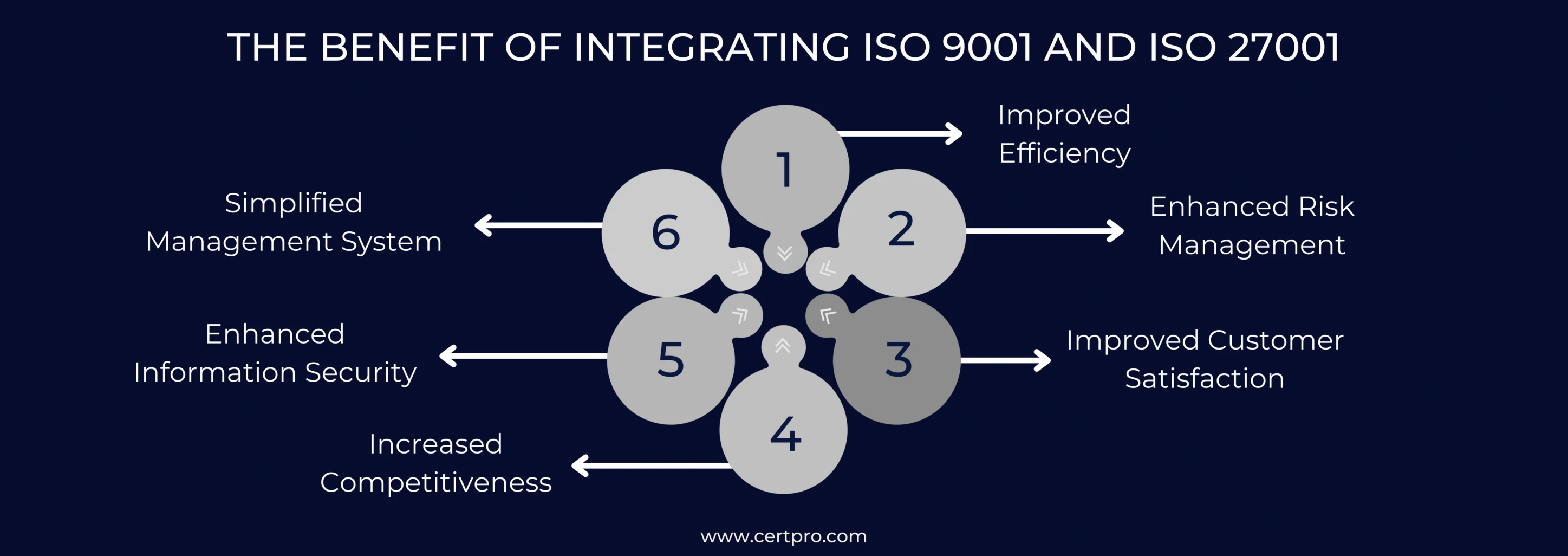
Achieve international standards with CertPro’s expertise
Getting certified in ISO 9001 and 27001 will give your organization a better experience despite the difficulties of the implementation process and strategies. ISO 9001 vs ISO 27001 standards are similar at some points, which makes it easier to see how to proceed. However, you still have some questions about how it all works. You can get assistance from CertPro, a well-known auditing and management consulting company. We help companies worldwide with custom services like ISO 27001 and ISO 9001 certification. In addition, we have professional auditors who help in the certification process. Please visit CertPro.com and contact us for more details. Businesses collaborating with CertPro can confidently use their skills to get certified. Our clients will get top-notch, cost-effective, practical, and tailored services. CertPro aims to help companies certifying ISO 27001 and 9001 become more competitive and reach their strategic goals.
FAQ
What is the difference between an information security policy and an information security program?
An information security policy (ISP) is a set of rules and guidelines that an organization establishes to govern the use and protection of its information assets. An information security program (ISP), on the other hand, is a comprehensive and ongoing process that includes the development, implementation, and maintenance of information security policies, procedures, and practices to protect an organization’s information assets. The ISP is the operational implementation of those policies and guidelines.
What are the consequences of not having an effective information security policy?
The consequences of not having an effective information security policy can be severe. It may lead to unauthorized access to sensitive information, loss of data, damage to the organization’s reputation, legal and regulatory compliance issues, financial losses, and disruption to business operations. This can have far-reaching consequences, including loss of revenue, loss of customer trust, and potential legal liabilities.
What are some common mistakes to avoid when developing an information security policy?
Some common mistakes to avoid when developing an information security policy include:
- Failing to involve key stakeholders in the development process
- Writing a policy that is too vague or too prescriptive
- not providing adequate training and education to employees
- Failing to regularly review and update the policy to ensure it remains relevant and effective
- failing to align the policy with business objectives and risk appetite.
By avoiding these common mistakes, organizations can ensure that their information security policy is effective and helps protect sensitive information from cyber threats.
How long does it take to get certified for ISO 9001 or ISO 27001?
The time required to obtain ISO 9001 or ISO 27001 certification varies with an organization’s size and complexity. The process typically takes months to a year and involves several steps, including audits and ongoing compliance maintenance.
Can a company be certified for both ISO 9001 and ISO 27001 at the same time?
Companies can pursue both ISO 9001 and ISO 27001 certifications together by implementing an integrated management system. IMS consolidates management systems, saves time, and reduces costs by managing multiple aspects. Separate audit processes are still required for each standard, but an integrated audit can also be performed.

About the Author
BENEDICT ESSANDOH
Benedict Essandoh, CertPro’s Regional Director in Ghana, is a compliance and ISO standards expert. Specializing in health and safety, he conducts audits, implements ISO 9001 and ISO 45001, and excels in accident investigation and site inspections, ensuring international standards are met.
HOW DOES ISO 27001 FOR STARTUPS IN INDIA HELP TO MEET GLOBAL STANDARDS?
India is the world’s fifth-largest economy, with a vibrant startup ecosystem that supports young professionals in making global changes. After the US and China, India ranks third globally for startup businesses. In this fascinating scenario, ISO 27001 for startups in...
IS SOC 2 THE SAME AS ISO 27001?
In today's digital landscape, ensuring the safeguarding of client data is paramount for businesses. Adhering to recognized compliance standards is vital to meeting this demand. ISO 27001 vs. SOC 2 represent two prominent benchmarks in the realm of data security with...
WHO NEEDS ISO 27001 CERTIFICATION AND WHY?
The esteemed ISO 27001 security framework is designed to evaluate the effectiveness of an organization's Information Security Management System (ISMS) in safeguarding its data. Obtaining ISO 27001 certification is a practical way for a corporation to demonstrate its...

